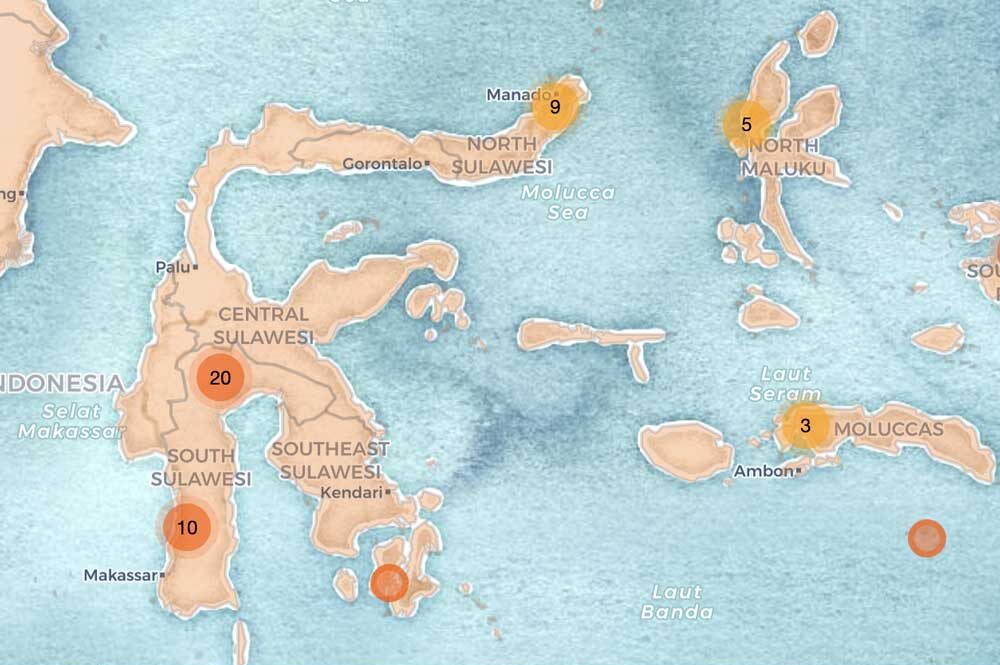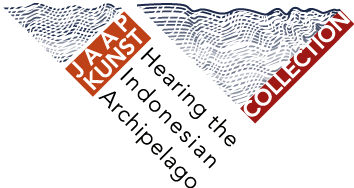The Map and the Sound Archive
By Otto Stuparitz
Nias, Indonesia. Photo by Jaap Kunst
A map serves as an important tool for finding materials stewarded within the Jaap Kunst Collection: Hearing the Indonesian Archipelago. Mapping and exploration go hand-in-hand as colonial legacies that helped constitute the contemporary Indonesian nation state. Sixteenth-century European speculators traveled through the archipelago looking for spices and other luxury goods. Among the many actions of capture and classification, these speculators mapped their journeys. The extent of the Dutch colonial territory became the basis of the Indonesian national map. From this colonially derived geo-body, postcolonial Indonesians have set out to create a coherent national identity, a persistent political project full of contradictions and tensions.
In this exhibition I point out how the map function of the Jaap Kunst Collection: Hearing the Indonesian Archipelago facilitates searchability while also reinscribing notions of the locality of sound. The act of recording produced notions of local sound. By documenting and capturing a sound in a certain place, European scholars soon created theoretical ideologies that defined certain sounds as belonging in certain places and certain places as having certain sounds. One of the central early ideologies, the dangerous logic of cultural evolutionism, further maps certain races and their sounding bodies onto certain geographies. This analytical goal was a hobbyhorse of the emerging comparative musicologists who sought to study the musics of the world through collecting sound recordings. As a field recordist, Jaap Kunst collaborated with comparative musicologists, but Kunst’s scholarship pushed away from the evolutionary tradition by advocating for the culture concept. Despite the theoretical break Kunst hoped to make, the technologies of recording and mapping he used to conduct and define his fieldwork remain loaded with paradoxes. While seeking to describe the musical cultures of specific groups, Kunst’s methods reinforced Dutch-defined geographies and display the power imbalances of colonial relations. These systems of power and geography continue to resound on our digital mapping tool.
Questions of Power and Colonial Mapping in the Locality of Sound
Here is an image from our map of Sulawesi and the Maluku Islands. A quick glance would suggest the recordings mapped onto these territories came from these areas.

If we zoom in on the bottom right, to part of the Maluku Islands, we see one recording mapped onto the Banda Islands, the originating source of the spices nutmeg and mace and driver of Dutch colonialization, and three recordings mapped onto Seram Island.

Comparing Two Points of Recording
Looking at recordings from each point opens a separate list of questions.
The metadata for the recording from the Banda point is described as a “Field recording made in 1932 by Jaap Kunst in Banda, Indonesia.” The instrumentation, gong sembilan (9 gongs), gives a clue to understand the recorded sound as a kind of pitched idiophone. The archivist’s original title is listed as “[Recorded music from Banda].” Each word in this title tells us something and leaves other things out. Who did the recording? Jaap and his wife Kathy were both part of this trip. The word music means that these sounds were understood as musical and not as noise or as a naturally given sonic backdrop. The use of “from” suggests that this music belongs to or within a certain place. Banda is both general and specific. Banda is a small archipelago of ten islands with indigenous people and people descended from migrants. The archipelago has been globally connected since at least the Srivijaya Kingdom (thirteen century), if not earlier. What does it mean to be categorized as “Recorded music from Banda” in the Jaap Kunst Collection? How do questions about power and colonially mapping help us more deeply appreciate this recording?
The other point opens up a separate list of questions.
One of the recordings entitled “Mareune” is described in the metadata as a “Field Recording at the Fourth Pan-Pacific Congress and Ethnographic Exhibition, Weltevreden, Jakarta, May 1929 (Seram, Indonesia).” The exhibition was held in Weltevreden, the colonial name for parts of modern-day Central Jakarta, particularly the subdistricts of Sawah Besar, Gambir, Senen, and Menteng. The metadata for “Location/Place of the Cultural Origin” and “Location Created/Recording Place” is listed as Morekau, a village-level place in contemporary West Seram. The metadata is in tension with itself. This tension builds (hopefully) productive friction and demands more inquiry.
What was the Fourth Pan-Pacific Congress and Ethnographic Exhibition? What does it mean to be a “field recording” at this exhibition compared with the “field recording” from Banda? Where or what is the “field”? How did this exhibition serve as a staging ground for collection and future staging at museums, archives, and World’s Fairs?
How was this recording’s vocalist, Banita, selected to travel? Who did the selecting? Was it colonial administrators in the region, from urban centers in Java, or Jaap Kunst? What other regional or community groups and individuals had agency in this process? How did she (based on my listening of the vocal register) travel? What did she bring with her? Did she return to the Maluku Islands, stay in Jakarta (Batavia/Weltevreden), or keeping going somewhere else? How was she compensated? Why do we know her name when so many musicians remain uncredited in these “field recordings”? Did she have political status? What did she hope to achieve from this recording? The list goes on . . .
By being open about some pitfalls in our presentation, hopefully listeners can approach the Jaap Kunst Collection: Hearing the Indonesian Archipelago with big ears and open eyes to this layered process. By realizing that the map is less an accurate representation than a finding aid, we begin to ask questions about our role in the curatorial process of reinscribing a sense of place for captured sound. These kinds of questions do not always lead to easy answers but unfastens important pathways towards deeper understandings of our shared pasts and collective futures.
Other Examples Complicating the Locality of Sound:
Recommended Reading:
Anderson, Benedict. 2006. Imagined Communities: Reflections on the Origin and Spread of Nationalism. London: Verso.
Miller, Karl Hagstrom. 2010. Segregating Sound: Inventing Folk and Pop Music in the Age of Jim Crow. Durham, NC: Duke University Press.
Winichakul, Thongchai. 1997. Siam Mapped: A History of the Geo-body of a Nation. Honolulu: University of Hawaii Press.
